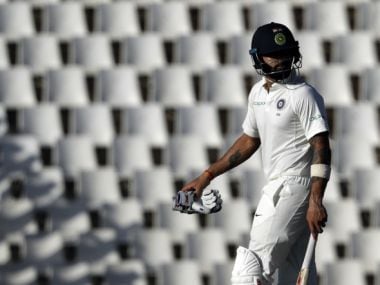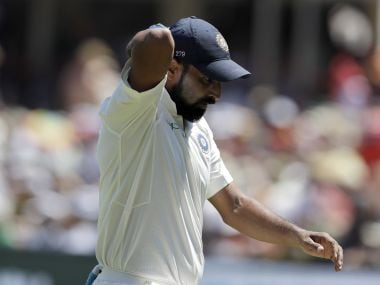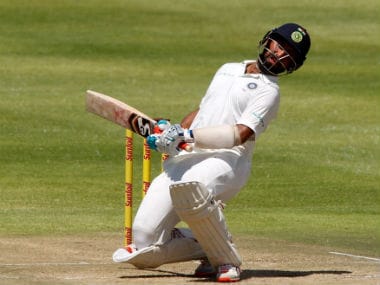India vs South Africa: Virat Kohli, AB deVilliers' Centurion dismissals reveal rare flaw in their techniques
As good as de Villiers and Kohli are, their superhuman stature suffered a minor blip on Day 4 in Centurion after technical glitches were possibly identified in their batting.
Rohit Sankar, Jan,17 2018
- Tri-Series in UAE, 2018 IRE Vs SCO Ireland beat Scotland by 6 wickets
- Pakistan in New Zealand, 5 ODI Series, 2018 NZ Vs PAK New Zealand beat Pakistan by 5 wickets
- Bangladesh Tri-Nation Series, 2018 BAN Vs ZIM Bangladesh beat Zimbabwe by 8 wickets
- England in Australia, 5 ODI Series, 2018 AUS Vs ENG England beat Australia by 5 wickets
| Rank | Team | Points | Rating |
|---|---|---|---|
| 1 | India | 4969 | 124 |
| 2 | South Africa | 3888 | 111 |
| 3 | Australia | 4174 | 104 |
| 4 | New Zealand | 3489 | 100 |
| 5 | England | 4829 | 99 |
| 6 | Sri Lanka | 4058 | 94 |
| Rank | Team | Points | Rating |
|---|---|---|---|
| 1 | South Africa | 6386 | 120 |
| 2 | India | 6680 | 119 |
| 3 | England | 6320 | 115 |
| 4 | New Zealand | 6404 | 114 |
| 5 | Australia | 6012 | 113 |
| 6 | Pakistan | 4811 | 96 |
| Rank | Team | Points | Rating |
|---|---|---|---|
| 1 | New Zealand | 2262 | 126 |
| 2 | Pakistan | 2843 | 124 |
| 3 | India | 3385 | 121 |
| 4 | England | 2029 | 119 |
| 5 | West Indies | 2538 | 115 |
| 6 | South Africa | 2238 | 112 |





“It’s not like only two guys are playing in this series. AB (de Villiers) is a great friend of mine. I respect the way he plays the game and I have always respected him as a person as well. Every player wants to be the stand out batsman and make contributions towards the team winning. Unless you have that as a group, you don’t have too many chances of winning a series. Some people may have brilliant individual performances and then you will be fine with one or two people doing well,” Kohli had said prior to the series when questioned about his battle with the South African star batsman.
Virat Kohli leaves the field after being dismissed by South Africa's Lungi Ngidi on the fourth day of the second Test. AP
They say cricket is a 22-member sport and Kohli's words emphasised on how you need to stand up as a group to win a Test series. But four days into the Centurion Test match and it is already turning into a battle between two modern day geniuses — Virat Kohli and AB de Villiers.
If it was de Villiers who set the series alive with an exhibition of counter-attacking cricket in the first Test in Cape Town — an innings that arguably won hosts the Test, plausibly even the series — it was Kohli who fought back with a breathtaking 153, his eleventh score of over 150 in Tests, in the first innings of the second Test in Centurion.
The battle between the two seems to have no end. Kohli's intent and positive approach at the crease was so impressive that de Villiers probably took cue from it in South Africa's second innings on a treacherous Centurion track.
Kohli’s 153 came with India struggling at 28/2 in the first innings. In the company of Murali Vijay and later Ravichandran Ashwin, the Indian skipper not only resuscitated the Indian innings, but also gave it some much-needed oomph, taking India close to South Africa's first innings total.
De Villiers had an even more crucial role to play. In the second innings, his team lost two wickets for just three runs when when he jogged in on his home ground. Aiden Markram and Hashim Amla had both been sent back by Jasprit Bumrah, but the factor more worrying was the low bounce on this subcontinent-like wicket.
Not for de Villiers, though. He bats on a different planet against most attacks on most wickets. He flicked Bumrah for four through fine-leg off the first ball he faced and reverse-swept Ashwin off the second ball he faced from the off-spinner. What unfolded over the course of the day was a pristine, delicately-beautiful knock studded with ten hits to the fence.
Not for once did he appear as if he had been out of Test action for more than a year before making his comeback just weeks ago. Playing the ball late, defending with intent, punching subtly, driving elegantly and flicking animatedly, de Villiers once again had India and Kohli on the mat.
On Day 4, de Villiers just took off from were he left the previous day. Runs came thick and fast and the game was slowly, but surely slipping out of India's grasp when the unthinkable happened.
A plausible chink in de Villiers’ batting?
Mohammad Shami’s first ball of the day was nonchalantly dabbed to the third man boundary for four by de Villiers, playing late and getting on top of the bounce. But the first ball of his next over, Shami managed to hit the exact same length and generate uneven bounce. The ball kicked off the surface and a surprised de Villiers, trying to dab through third man again, found a thick edge to Parthiv Patel behind the stumps.
In a way, the dismissal can be put down to the unevenness of the pitch. But take a glance at de Villiers’ technique a bit and you see that India might just have accidentally hit upon a probable weakness in his technique.
In the first innings, Ishant Sharma had landed the ball short at de Villiers and the South African middle-order batsman tried to push it through to third man with an angled bat. The inside edge crashed onto the stumps. The dismissal in the second innings had also come when he was trying to force the ball through third man.
On two-paced wickets with uneven bounce, the horizontal and vertical shots need to come out perfectly or else you are always in danger of chopping one onto the stumps or edging to the keeper.
Roll back to 2013-14 and the famous Johannesburg Test between India and South Africa. Faf du Plessis and AB de Villiers were going strong in a chase of 459 on a relatively flat, yet tiring wicket. But out of the blue, the 205-run stand was broken with South Africa closing in on victory.
Ishant Sharma charged in from over the wicket and bowled a back of a length ball outside off-stump. de Villiers looked to nudge it through a vacant slip cordon only managed to chop it onto the stumps off an inside edge.
The dismissal at Centurion in the first innings of this Test was eerily similar to that one at Johannesburg (including the fact that it was the same bowler).
Batsmen are often instructed to play the ball with a perfectly horizontal or perfectly vertical bat by coaches and commentators on air. This is because anything in between and you bring the edge of the bat a lot more into play. But with the evolution of cricket — shorter formats advocating hitting across the line and golf-swing with the cricket bat — the 45° angled shots have become more prominent.
Perhaps, it is this minor weakness that teams would want to expose in de Villiers’ batting. Mind you, his impeccable hand-eye coordination and amazing bat speed more often than not covers up for this slight flaw in technique but it could be a possible avenue to attack.
That said, his 121-ball 80 had given the Proteas the momentum to set a target which hasn't yet been breached at the SuperSport Park.
If de Villiers has a weakness, Kohli has it too.
India had lost the plot in a chase of 287 despite several experts from various quarters backing this Kohli-led unit to create history at SuperSport Park. At 16/2, India’s sole hope rested on the Indian skipper.
But all such notions were dispelled as Lungi Ngidi — thriving off a bonus wicket from a reckless shot from KL Rahul — angled one into the Indian skipper, who plonked his front foot forward and missed the flick. Even a desperate review — a wasteful one at that — couldn't save the skipper.
Kohli might have been an exhibition of class and elegance in the first innings but Ngidi and South Africa for sure have found a way to dismiss him, apart from his well known fourth-stump woes, of course.
Philander had exposed Kohli’s vulnerabilities against the ball seaming into his pads in the first Test in Cape Town. In the second innings of the last Test, the meticulous South African seamer stuck to a line outside the off-stump — often cited as Kohli’s weak point — and then moved one back into him eleven balls later to trap him in front.
In the first innings in Centurion, Ngidi nearly had a dream maiden scalp when he struck Kohli on the front pad, albeit off an inside edge, while he tried to flick.
“I thought I had him,” Ngidi had said after the second day's play. “I thought he had hit the ground, so I was very confident. When I saw that edge (on the replay), I kind of dropped a bit, but I knew I had to get back on the ball.”
The second time, though, Kohli wasn't as lucky and Ngidi had him trapped in front. Taking cue from Philander in the first Test, Rabada and Ngidi were probing an unexplored angle to Virat Kohli.
On Indian wickets, the sensational No 4 would flick the ball blindfolded through mid-wicket. But here, with a touch of seam movement, Kohli’s intent-filled batting has more than a minor weakness and the Proteas have exploited it brilliantly.
As good as de Villiers and Kohli are, their superhuman stature suffered a minor blip on Day 4 in Centurion after technical glitches were possibly identified in their batting. With 13,786 Test runs between them, these two share much more than a kinship built on Royal Challengers Bangalore's after-match parties. They are modern-day greats, pioneers of the latest evolution in batting techniques and any weakness found may not hold true two days later with a zillion videos and technical analysts available to iron out flaws. A rather eventful day, nonetheless, for the present day Gods of cricket.
Published Date:Jan 17, 2018
| Updated Date: Jan 17, 2018
Also See
India vs South Africa: Jasprit Bumrah says team 'doesn't deserve' to play Tests if their confidence is dented after one loss
India vs South Africa: Virat Kohli and Co need to arrest AB de Villiers-led charge early on Day 4
India vs South Africa: From Vernon Philander's fire to AB de Villiers' ice, factors that turned Cape Town Test around